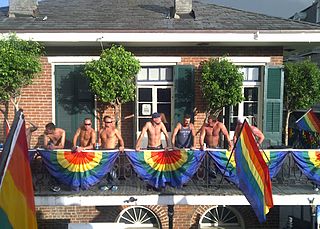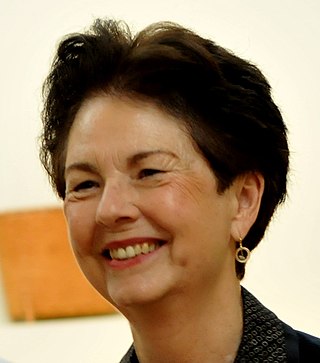Related Research Articles

A krewe is a social organization that stages parades and/or balls for the Carnival season. The term is best known for its association with Mardi Gras celebrations in New Orleans, but is also used in other Carnival celebrations throughout Louisiana and along the Gulf of Mexico, such as the Gasparilla Pirate Festival in Tampa, Florida, Springtime Tallahassee, and Krewe of Amalee in DeLand, Florida with the Mardi Gras on Mainstreet Parade as well as in La Crosse, Wisconsin and at the Saint Paul Winter Carnival.

The holiday of Mardi Gras is celebrated in southern Louisiana, including the city of New Orleans. Celebrations are concentrated for about two weeks before and through Shrove Tuesday, the day before Ash Wednesday. Mardi Gras is French for Fat Tuesday, the season is known as Carnival and begins on 12th Night, January 6th, and extends until midnight before Ash Wednesday. Club, or Krewe, balls start soon after, though most are extremely private, with their Kings and Queens coming from wealthy old families and their courts consisting of the season's debutantes. Most of the high society Krewes do not stage parades. As Fat Tuesday gets nearer, the parades start in earnest. Usually there is one major parade each day ; many days have several large parades. The largest and most elaborate parades take place the last five days of the Mardi Gras season. In the final week, many events occur throughout New Orleans and surrounding communities, including parades and balls.

Southern Decadence is an annual, six-day, LGBTQ-based event held in New Orleans, Louisiana during Labor Day weekend, culminating in a parade through the French Quarter on the Sunday before Labor Day.
WZRH is a radio station owned by Cumulus Media. The station has an effective radiated power of 100 kW, is licensed to Laplace, Louisiana and serves the greater New Orleans and Baton Rouge metropolitan areas. Its studios are located at the Place St. Charles building in Downtown New Orleans and its main transmitter is located in Laplace, Louisiana.

The Times-Picayune/The New Orleans Advocate is an American newspaper published in New Orleans, Louisiana. Ancestral publications of other names date back to January 25, 1837. The current publication is the result of the 2019 acquisition of The Times-Picayune by the New Orleans edition of The Advocate in Baton Rouge, Louisiana.

American Routes is a weekly two-hour public radio program that presents the breadth and depth of the American musical and cultural landscape. Hosted by Nick Spitzer, American Routes is syndicated by 225 stations, with over half a million listeners. It is produced out of New Orleans and distributed by PRX. American Routes is the most widely heard regular presence for tradition-derived and community-based music on public radio today.

The culture of New Orleans is unique among, and distinct from, that of other cities in the United States, including other Southern cities. New Orleans has been called the "northernmost Caribbean city" and "perhaps the most hedonistic city in the United States". Over the years, New Orleans has had a dominant influence on American and global culture.
Seymour Weiss was a prominent hotel executive and civic leader from New Orleans, Louisiana, who was a close confidant of the legendary Huey Pierce Long, Jr. Weiss, the most loyal of the Longites, bore the same last name as the apparent Long assassin, Carl Weiss, M.D.

Mignon Faget is a jewelry designer based in her native New Orleans, Louisiana. Faget has long been acknowledged as one of New Orleans' premier designers of fine jewelry.

The New Orleans Museum of Art is the oldest fine arts museum in the city of New Orleans. It is situated within City Park, a short distance from the intersection of Carrollton Avenue and Esplanade Avenue, and near the terminus of the "Canal Street - City Park" streetcar line. It was established in 1911 as the Delgado Museum of Art.

Mardi Gras is the annual Carnival celebration in Mobile, Alabama. It is the oldest official Carnival celebration in the United States, started by Frenchman Nicholas Langlois in 1703 when Mobile was the capital of Louisiana. Although today New Orleans and South Louisiana celebrations are much more widely known for all the current traditions such as masked balls, parades, floats and throws were first created there. From Mobile being the first capital of French Louisiana (1702), the festival began as a French Catholic tradition. Mardi Gras has now evolved into a mainstream multi-week celebration across the spectrum of cultures, becoming school holidays for the final Monday and Tuesday, regardless of religious affiliation.
Lyle Saxon was a writer and journalist who reported for The Times-Picayune in New Orleans, Louisiana. He directed the Federal Writers' Project Works Progress Administration (WPA) guide to Louisiana.

Gert Town is a neighborhood in the city of New Orleans, Louisiana. It is the home to Xavier University of Louisiana and is near Mid-City. Gert Town played a major role in the industrial development of the New Orleans region. The Blue Plate Mayonnaise Factory, Coca-Cola Bottling Plant, Sealtest Dairy, and Thompson-Hayward Chemical Company were all fundamental manufacturing bases of the working-class neighborhood. Gert Town was also well known for being a center of development for jazz and other music genres. Musicians such as Buddy Bolden, John Robichaux, Merry Clayton, Bunk Johnson and Allen Toussaint all came from the neighborhood and helped shape the musical influence of New Orleans.

Mardi Gras in the United States is celebrated in a number of cities and regions in the country. Most of these places trace their Mardi Gras celebrations to French, Spanish, and other Catholic colonial influences on the settlements over their history.
John James Maginnis was a writer of columns and commentaries on current political events in his native Louisiana Maginnis' column appeared in newspapers and other sources statewide. His website is read by political analysts nationwide as a barometer of governmental trends and events in Louisiana.

William (Kross) Greiner in New Orleans, Louisiana, is an American photographer and multi-media artist living in Santa Fe, NM.
Malaika Favorite is an American visual artist and writer whose art work can be found in major collections in the U.S. She works mainly in oil, acrylic, and watercolor and has carried out experiments with folded canvas and the written word as another dimension of a painting's text. Her provocative paintings and sculpture pieces emanate as much from her personal history as it does from the wider world.
New Orleans Review, founded in 1968, is a journal of contemporary literature and culture that publishes "poetry, fiction, nonfiction, art, photography, film and book reviews" by established and emerging writers and artists. New Orleans Review is a publication of the Department of English at Loyola University New Orleans. Lindsay Sproul is the current editor-in-chief.
The following is a timeline of the history of the city of New Orleans, Louisiana, USA.
References
- ↑ John K. Lawson, Hurricane Hotel: A Novel, 2008.
- ↑ "The New Orleans Times Picayune: The color's the thing for bead artist" November 9, 2001
- ↑ "The Baltimore Sun", October 16, 2002, "AVAM Just Says Yes to the Art of Addiction"
- ↑ NBC News "Mardi Gras Beads Make Fine Art"
- ↑ "The Daily News" of Newburyport, Massachusetts. Sonya Vartabedian, March 3, 2006
- ↑ NBC News "Mardi Gras Beads Make Fine Art"
- ↑ Mardi Gras Made in China Archived 2012-01-02 at the Wayback Machine . Directed by David Redmon.
- ↑ Laney, Ruth. "Piecing Together the Blues: John Lawson creates collage portraits of iconic Baton Rouge Bluesmen". Country Roads. Retrieved March 23, 2018.
- ↑ "John Lawson". Berkshire Edge.
- ↑ "John K. Lawson". Country Roads.
- ↑ John K. Lawson, Hurricane Hotel: A Novel, 2008.
- ↑ "The Daily News" of Newburyport, Massachusetts. Sonya Vartabedian, March 3, 2006
- ↑ "The New Orleans Times Picayune: The color's the thing for bead artist" November 9, 2001
- ↑ NBC News "Mardi Gras Beads Make Fine Art"
- ↑ "The Baltimore Sun", October 16, 2002, "AVAM Just Says Yes to the Art of Addiction"
- ↑ John K. Lawson, Hurricane Hotel: A Novel, 2008.
- ↑ Mardi Gras Made in China Archived 2012-01-02 at the Wayback Machine . Directed by David Redmon.